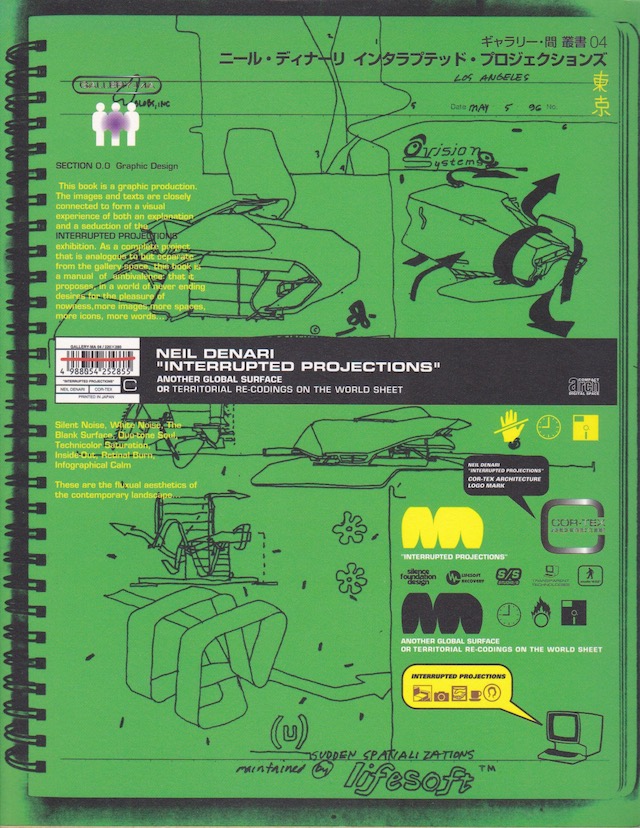Interrupted Projections
Interrupted Projections: Another Global Surface, or Territorial Recodings on the WorldSheetNeil DenariTOTO Publishing, September 1996Paperback | 8-3/4 x 11 inches | 87 pages | Japanese/English | ISBN: 9784887061422 | 1500¥EXHIBITION DESCRIPTION:GALLERY MA featured the work of the young Las Angeles architect Neil M. Denari in a show titled "INTERRUPTED PROJECTIONS." Denari has won wide acclaim for his various projects, such as his radical entry in the Tokyo International Forum Competition for which he received Honorable Mention. While not quite breaking free from the constraints of tradition and standards, Denari seems to challenge the conservatism of contemporary "architecture," always making viewers conscious of the essence of architecture and its latent potential.For Denari, contemporary architecture exists within a society filled with a mixture of coded images that trancends the concrete "thing" itself. Denari seeks to discover the possibilities of architecture within such a society, as well as how architecture can be made to fuse with society. Denari offered one solution to these questions in the space of GALLERY MA.The exhibition area was equipped with a NaviCam (support: Sony Computer Science Laboratory, Inc.), which will serve as a device for visualizing the concepts of the exhibition. Individual visitors could analyze concepts by accessing barcodes scattered throughout the exhibition area.GALLERY MA also sold "GALLERY MA BOOKS 04 Neil M. Denari INTERRUPTED PROJECTIONS," a graphic two-dimensional presentation of the show as realized in the three-dimensions of GALLERY MA.REFERRAL LINKS: dDAB COMMENTARY:One of the eighteen lecture introductions included in David Erdman's new book, Introducing: Short Essays on Influential Thinkers and Designers in Architecture, is for Neil Denari, the Los Angeles architect known best for a building in New York City, HL23. The lecture for which Erdman was introducing Denari took place in 2013, not long after that building's completion. Perhaps because the lecture was half a world away, in Hong Kong, Erdman focused mainly on Denari's earlier books and exhibitions, the output that brought him a good deal of attention in the 1990s, well before he had the opportunity to realize a building. One such exhibition was Interrupted Projections, which was on display at TOTO's Gallery MA in fall 1996 and was accompanied by a slim, handsome book of the same name.Rather than wait for Denari's much anticipated first monograph, Gyroscopic Horizons, which was a perpetual tease at the time — it was finally released in 1999 — I opted to buy Interrupted Projections when it came out, in one of many binges at Prairie Avenue Bookshop. Years later I scanned some pages from it for a "weekly dose" on the Massey Residence, one of seven projects in the book. The projects — all unbuilt, minus the exhibition itself — are documented with Denari's exacting graphic skill. He describes it in the introduction as "a graphic production," with "images and text [...] closely connected to form a visual experience of both an explanation and seduction" of the exhibition. Each project is its own "section" (1.0, 2.0, etc.) with a theme related to mass production, branding, globalization, and other concerns, spelled out in dense language very much of its time.The graphics also appear dated, especially the prevalence of boxes with rounded corners defining the boundaries of text and images. This was 1996, after all, when computers had already influenced graphic design and were just starting to work their way into architectural practice. Denari was an early adopter, using software to help model smooth forms and surfaces but also creating an aesthetic of computer-generated architecture. With very little white space, the book is a visual feast, with renderings and text fitted onto the page alongside barcodes, logos, colored shapes — any graphics to fill the page and convey a sense of coolness. I'm not sure how well the book captured the "visual experience" and "seduction" of the exhibition, but today it stands as an excellent illustration of architectural thinking twenty-five years ago.SPREADS:

Neil Denari
TOTO Publishing, September 1996
Paperback | 8-3/4 x 11 inches | 87 pages | Japanese/English | ISBN: 9784887061422 | 1500¥
EXHIBITION DESCRIPTION:
REFERRAL LINKS:
SPREADS:








